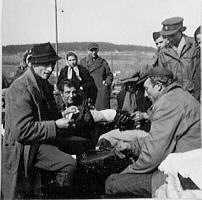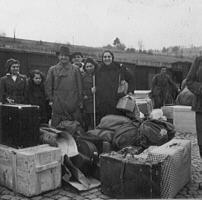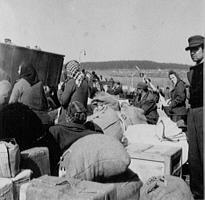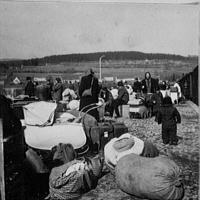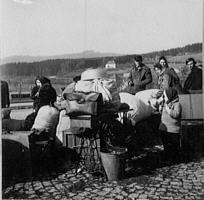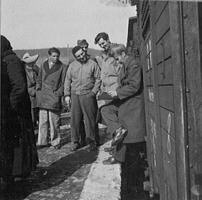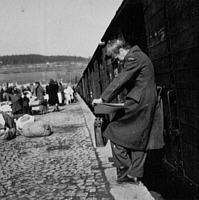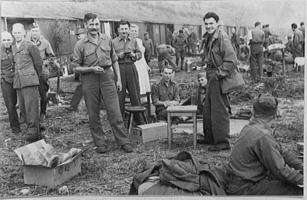 Shortly
after the camp was taken over by the Americans, the displaced people
started to arrive. First they were brought in by army trucks, appearing
at the main gate, easily absorbed into the refugee population. Then
they came via the train station. They came in batches of 500 to 4,000.
They arrived in cattle cars, men with haggard faces, grannies shawled
and wearing babuskas, women and children peering out of the cattle
car doors. Often before arriving at this, their final destination
they would run out of food or diapers for the babies. New babies would
be born; some passengers were even left behind at sanitations stops......
Shortly
after the camp was taken over by the Americans, the displaced people
started to arrive. First they were brought in by army trucks, appearing
at the main gate, easily absorbed into the refugee population. Then
they came via the train station. They came in batches of 500 to 4,000.
They arrived in cattle cars, men with haggard faces, grannies shawled
and wearing babuskas, women and children peering out of the cattle
car doors. Often before arriving at this, their final destination
they would run out of food or diapers for the babies. New babies would
be born; some passengers were even left behind at sanitations stops......
When the Repatriation Program started, many refugees decided to go
back to their homelands. It was times like this that the station took
on a spirit of hope and gaiety as those returning boarded the cattle
cars and nailed up make-shift flags and decorated with flowers and
branches gathered from nearby field. When chalk was available, sketches
of their heros and slogans would appear on the cars as well as names
of villages and hamlets in Poland. The trip would take five days and
the UNRRA supplied food, blankets, candles and firewood. Friends and
relatives would offer final bon voyage presents - bottles of home-brewed
schnapps, or sausage. On the platform a DP band would play polkas,
and as the train would pull out, the band would switch to the Polish
National Anthem, and everyone would lift their voices in song. The
crowds would wave till the last car had passed and the sound of the
whistle blowing would fade away....... These scenes would be repeated
over and over again. Well over 100,000 refugees coming in and going
home, but eventually the doors of communism closed in around eastern
Europe, and the refugees had to find homes in other countries...........
Kurz
nach dem Lager Wildflecken von den Amerikanern übernommen worden
war, kamen bereits die ersten "Displaced People" in das
Lager. Zuerst kamen sie auf amerikanischen Militär-LKW, später
nachdem die gesprengten Brücken der Bahnlinie wieder repariert
waren, mit dem Zug. Meist waren es ca. 500 - 4.000 Personen, die in
einem Transport zusammengefasst waren. Benutzt wurden in der Regel
geschlossene Vieh- und Güterwagen. Die Menschen waren oft mehrere
Tage unterwegs, meist gingen bereits während der Fahrt die Vorräte
an Lebensmittel und Wasser zur Neige, Kinder wurden geboren.
Als die ersten Transporte zurück nach Polen begannen, wurden
die Wagen festlich geschmückt. Die UNRRA stellte ausreichend
Lebensmittel und Feuerholz für die 5 Tage dauernde Reise zur
Verfügung. Selbstgebrannter Schnapps und die Lager-Musikkapelle
machten den Abschied von den anderen Lagerbewohnern leichter. Die
polnische Nationhymne wurde gespielt. Als die Kommunisten ihre Macht
in Polen festigten, endeten die Transporte.
 Shortly
after the camp was taken over by the Americans, the displaced people
started to arrive. First they were brought in by army trucks, appearing
at the main gate, easily absorbed into the refugee population. Then
they came via the train station. They came in batches of 500 to 4,000.
They arrived in cattle cars, men with haggard faces, grannies shawled
and wearing babuskas, women and children peering out of the cattle
car doors. Often before arriving at this, their final destination
they would run out of food or diapers for the babies. New babies would
be born; some passengers were even left behind at sanitations stops......
Shortly
after the camp was taken over by the Americans, the displaced people
started to arrive. First they were brought in by army trucks, appearing
at the main gate, easily absorbed into the refugee population. Then
they came via the train station. They came in batches of 500 to 4,000.
They arrived in cattle cars, men with haggard faces, grannies shawled
and wearing babuskas, women and children peering out of the cattle
car doors. Often before arriving at this, their final destination
they would run out of food or diapers for the babies. New babies would
be born; some passengers were even left behind at sanitations stops......
